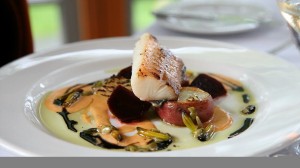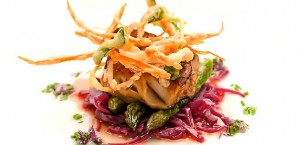Frederique Philip, owner of So oke Harbour House, is telling a story. A female guest of the inn and restaurant spotted a chef walking into the kitchen with a slaughtered lamb over his shoulder, and was so appalled that she wanted to check out.
oke Harbour House, is telling a story. A female guest of the inn and restaurant spotted a chef walking into the kitchen with a slaughtered lamb over his shoulder, and was so appalled that she wanted to check out.
Frederique asked the guest if she was a vegetarian, and the answer was “no.” So what was the problem? The guest had never made the connection between what she ate and where that food comes from.
If there is one definitive feature of Frederique’s restaurant, it is knowing where the food comes from: organic, local and fresh. To come to Sooke Harbour House and not make the connection between field and plate is an insult to the premise baked into the restaurant’s heart.
Sooke Harbour House is the culmination of 31 years of refinement and effort from the early days of serving local food in 1979.
Frederique says of herself and husband Sinclair, “When we got here, we did not want to do French or any other cuisine, because that is not what we have here.”
As a result of thi s simple mandate the Sooke Harbour House is a definitive locally grown and raised fresh food experience, predating the 100-Mile Diet, before Bishops and Ocean Wise and the ‘locavore‘ catch-phrase. Initiating a movement wasn’t a strategy or business move, it was just a common sense way for things to be done, the way food happened in France.
s simple mandate the Sooke Harbour House is a definitive locally grown and raised fresh food experience, predating the 100-Mile Diet, before Bishops and Ocean Wise and the ‘locavore‘ catch-phrase. Initiating a movement wasn’t a strategy or business move, it was just a common sense way for things to be done, the way food happened in France.
On a deeper level, there’s a fundamental difference in the European and North American relationships to food. In North America food has become an egalitarian affair, rather than epicurean. That sounds like a good thing, but it has led to vast industrialization of food production; only four companies produce approximately 80% of the beef in the United States.
With this industrialization comes risk, because these cattle do not lead happy lives.
Most often they are off to the abattoir wearing their own and other’s feces, with the resultant meat being chemically cleansed after the fact to reduce the risk of food poisoning. It’s not pretty, but often we eat it in disconnected ignorance.
Frederique has a bigger point that unfolds in four hours of dining and conversation overlooking the water, beach and gardens — and it’s not a soft and hippy-huggable sort that you’d expect from a champion of consuming local foods. Indeed, nothing of this conversation carries any new-age pretense; it is all deeply practical.
In reality the point comes back to the saying, “you are what you eat.” And to truly understand that statement we need a little history of what we’re eating.
 The rise of processed and branded food and ingredients occurred in the 19th century as populations moved to cities, where consumers needed convenience, but also safety.
The rise of processed and branded food and ingredients occurred in the 19th century as populations moved to cities, where consumers needed convenience, but also safety.
Brand name foods, the product of industrialization, attracted Victorian era consumers because the packaged ingredients were sterile, predictably available and subject to quality control. In short, residents of cities had a lesser chance of food poisoning by eating branded foods, and initially this all came at a premium.
The legacy of branded food is that the population of North America eats three times a day (more or less) without major outbreaks of food poisoning. A little salmonella on sprouts and a bit of mad cow throughout the US and Canada not withstanding. And here’s where the history goes wrong.
To meet consumer demands, food processing and storage has become more efficient and effective. A demand for a longer shelf life resulted in the increasing of preservatives. A demand for lower prices introduced high-fructose corn syrup and its siblings — obesity and diabetes. The demand for flavour saw the introduction of increasingly complex and potentially addictive designer flavours, which supplement the taste of convenience foods.
In the United States, consumption of energy-dense fast-food meals tripled and calorie intake quadrupled between 1977 and 1995. Check out the nutritional value, which brings us to “you are what you eat.”
“How are people supposed to think if they are not feeding their brains?” asks Frederique. “You would not put water into your car, and expect it to run. Why would you put junk in your body and expect it to run well? Expect your brain to be able to think?”
If you look at the current North American diet, decreased attention spans, the decline of literate and critical thinking, and potentially even the decline of political conversation and rhetoric, the theory has validity. The psychological symptoms of malnutrition after all are unresponsiveness, disinterest in one’s surroundings, listlessness, weariness, apathy, irritability and poor memory.
Our North American diet likely has direct bearing on our psychological health, in turn affecting every facet of our social and political behaviour. Suddenly the argument for being a locavore, or at least eating healthily, becomes one of national and international importance even beyond the obesity epidemic.
It also might be the answer to one of Frederique’s own questions, raised by receiving a lifetime achievement award at Vancouver Magazine’s 21st Annual Restaurant Awards. “I knew I was old then,” says Frederique, “but what do I do to get a second lifetime achievement award when I’m 90?” Perhaps healthy eating needs a champion on a grander scale, one who has already demonstrated its economic viability at a local level. At the very least Frederique Phillips has successfully raised this writer’s awareness to a broader nutritional issue.
Further information:


“As long as there are slaughterhouses, there will be battlefields.”
— Leo Tolstoy
i guess the woman in the opening of this article saw what i see, an animal that didnt even get a life before it was killed. perhaps she’ll now consider what she eats.
“The time will come when men such as I will look upon the murder of animals as they now look upon the murder of men.”
— Leonardo Da Vinci – >but what would he know?
this woman is hard, snobbish and cruel, just like her views toward animals, she’ll condone serving any creature to impress the snobs.
We can judge the heart of a man by his treatment of animals.
— Immanuel Kant
Michael Pollan’s book In Defense of Food is an excellent read on this very topic. Though, I must say that as someone who tries very hard to buy local, organic foods as much as possible it really does cause a massive financial issue. I could buy locally produced organic jam in a tiny bottle for about $7.00. Or I can go to Costco and get a one litre bottle of strawberry jam for the same price. I agree with the principle of buying organic but it’s misleading to say that it doesn’t cost more. It does. Organic produce is frequently 50% more expensive than the non-organic varieties.
Locally grown food is fantastic and shouldn’t really be expensive, but it often is. And it’s hard to know what to do in the winter when local offerings are scarce. And the fact of the matter is that it’s cheaper to buy a bag of chips than to buy locally grown organic potatoes, which is truly weird and awful. If we want people to make healthy food choices, healthy food has to be made accessible and affordable. Something that just isn’t happening right now. Compare a McDonald’s meal to eating at a restaurant that sources local food–you’re going to pay a fortune for the local meal and just a few dollars for the hamburger. So what are people with a limited budget supposed to do? It’s a terrible conundrum and a complicated problem.
Andrea,
I’ll be sure to add In Defence of Food to my reading list. I agree that it’s sad that local and or organic products often are accompanied by a huge difference in price. In reality, I wouldn’t advocate a complete shut-off of packaged or industrialized foods in one’s life, that’s just not feasible for most of us, but where we can choosing unpackaged or local foods helps. By supplementing our existing diets with more nourishing options, we are effectively voting with our dollars. In an ideal world that effects “Big Food’s” bottom line, encouraging change.
Great article! One of the things I often think while shopping at my local farmers market is how inexpensive great local produce can be. So much packaged produce just transfers profit from the farmer to the companies packaging and trucking it around, polluting the air and supporting the likes of BP.
For those who shop at Costco, start small… start buying your eggs from a local farmer, and find a farmers market. Ask around for locally raised chicken, turkey, etc. You’ll be amazed by not just how good it tastes, but that it’s not that much more expensive. You’ll also grow to love the stronger connection to the lands and agriculture near where you live.
Thanks for the feedback and ideas Gord!